UPS Strategic Management: Analysis of External and Internal Factors
VerifiedAdded on 2024/06/28
|12
|2615
|449
Report
AI Summary
This strategic management report provides a comprehensive analysis of United Parcel Service (UPS), examining both its external and internal environments. The analysis employs tools such as PESTLE, Porter's Five Forces, and SWOT to evaluate the factors impacting UPS's operations and strategic choices. The report identifies potential growth strategies, including limited and substantive growth, ultimately recommending the adoption of a substantive growth strategy to enhance capital gains and efficiency. Key areas for growth include expanding in high-growth international markets, focusing on B2B and B2C e-commerce, and entering the life sciences and healthcare logistics market. The report concludes by emphasizing the importance of adapting to internal and external factors to achieve organizational goals and objectives, highlighting the value of strategic analysis in ensuring business growth and competitiveness. Desklib offers a range of solved assignments and past papers for students.
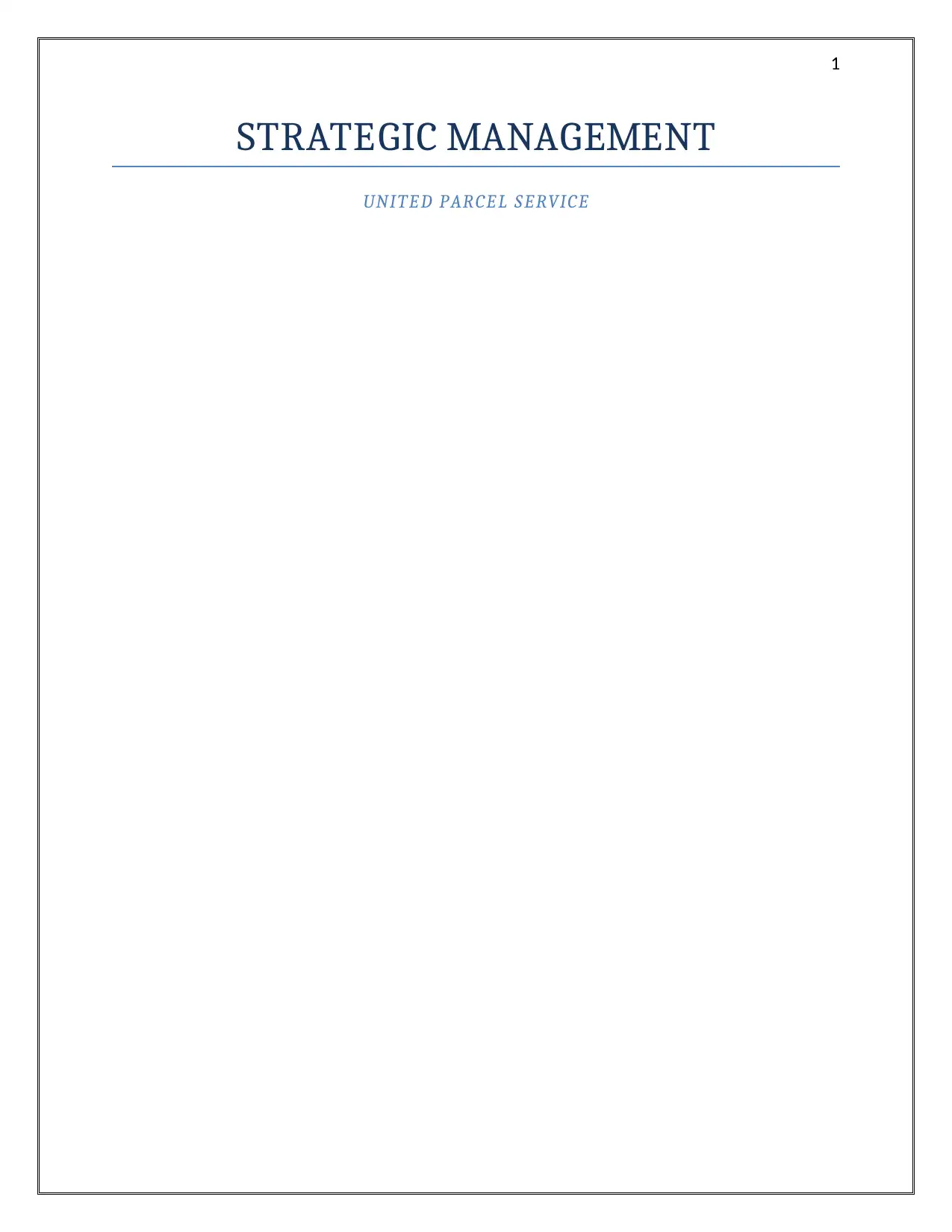
1
STRATEGIC MANAGEMENT
UNITED PARCEL SERVICE
STRATEGIC MANAGEMENT
UNITED PARCEL SERVICE
Paraphrase This Document
Need a fresh take? Get an instant paraphrase of this document with our AI Paraphraser
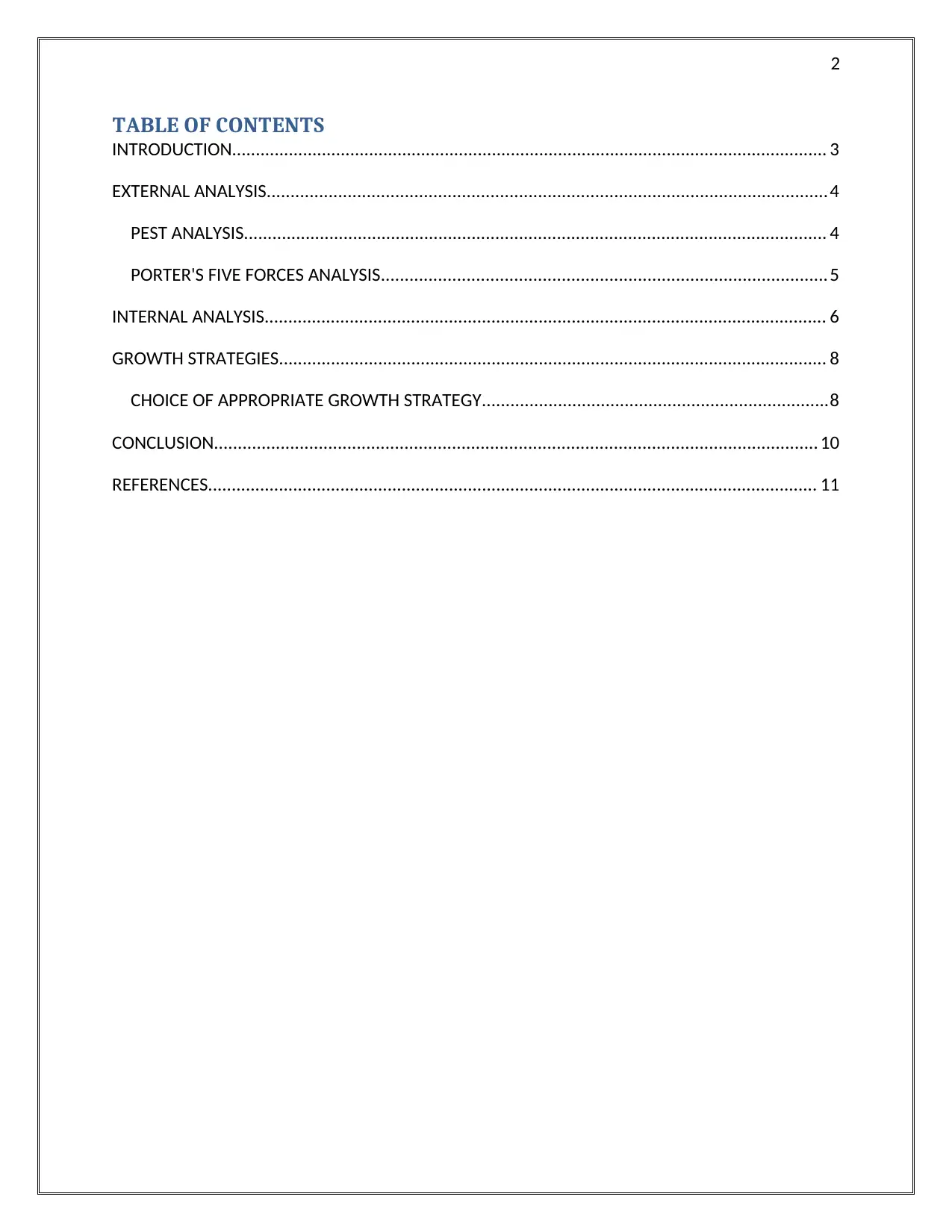
2
TABLE OF CONTENTS
INTRODUCTION.............................................................................................................................. 3
EXTERNAL ANALYSIS......................................................................................................................4
PEST ANALYSIS........................................................................................................................... 4
PORTER'S FIVE FORCES ANALYSIS..............................................................................................5
INTERNAL ANALYSIS....................................................................................................................... 6
GROWTH STRATEGIES.................................................................................................................... 8
CHOICE OF APPROPRIATE GROWTH STRATEGY.........................................................................8
CONCLUSION............................................................................................................................... 10
REFERENCES................................................................................................................................. 11
TABLE OF CONTENTS
INTRODUCTION.............................................................................................................................. 3
EXTERNAL ANALYSIS......................................................................................................................4
PEST ANALYSIS........................................................................................................................... 4
PORTER'S FIVE FORCES ANALYSIS..............................................................................................5
INTERNAL ANALYSIS....................................................................................................................... 6
GROWTH STRATEGIES.................................................................................................................... 8
CHOICE OF APPROPRIATE GROWTH STRATEGY.........................................................................8
CONCLUSION............................................................................................................................... 10
REFERENCES................................................................................................................................. 11
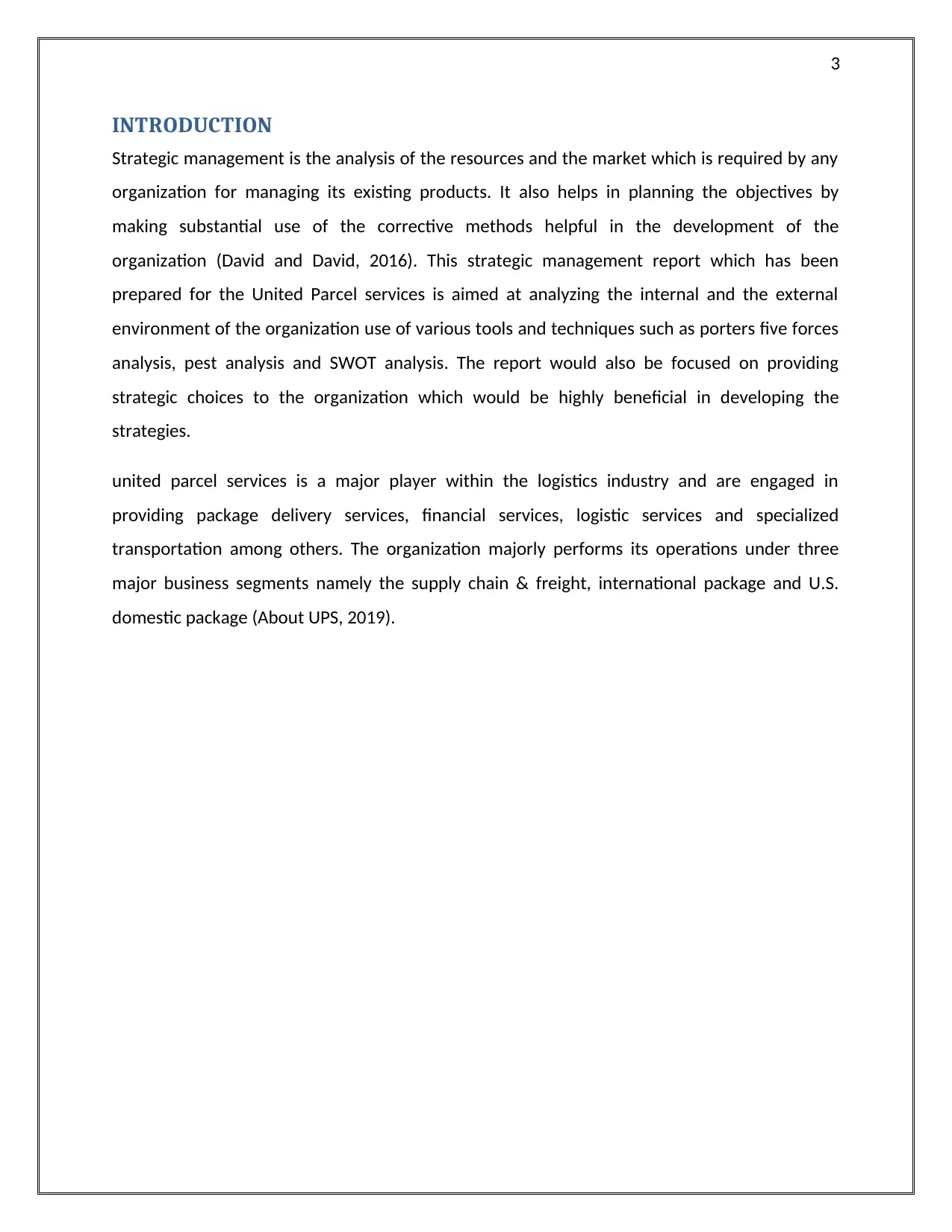
3
INTRODUCTION
Strategic management is the analysis of the resources and the market which is required by any
organization for managing its existing products. It also helps in planning the objectives by
making substantial use of the corrective methods helpful in the development of the
organization (David and David, 2016). This strategic management report which has been
prepared for the United Parcel services is aimed at analyzing the internal and the external
environment of the organization use of various tools and techniques such as porters five forces
analysis, pest analysis and SWOT analysis. The report would also be focused on providing
strategic choices to the organization which would be highly beneficial in developing the
strategies.
united parcel services is a major player within the logistics industry and are engaged in
providing package delivery services, financial services, logistic services and specialized
transportation among others. The organization majorly performs its operations under three
major business segments namely the supply chain & freight, international package and U.S.
domestic package (About UPS, 2019).
INTRODUCTION
Strategic management is the analysis of the resources and the market which is required by any
organization for managing its existing products. It also helps in planning the objectives by
making substantial use of the corrective methods helpful in the development of the
organization (David and David, 2016). This strategic management report which has been
prepared for the United Parcel services is aimed at analyzing the internal and the external
environment of the organization use of various tools and techniques such as porters five forces
analysis, pest analysis and SWOT analysis. The report would also be focused on providing
strategic choices to the organization which would be highly beneficial in developing the
strategies.
united parcel services is a major player within the logistics industry and are engaged in
providing package delivery services, financial services, logistic services and specialized
transportation among others. The organization majorly performs its operations under three
major business segments namely the supply chain & freight, international package and U.S.
domestic package (About UPS, 2019).
⊘ This is a preview!⊘
Do you want full access?
Subscribe today to unlock all pages.

Trusted by 1+ million students worldwide
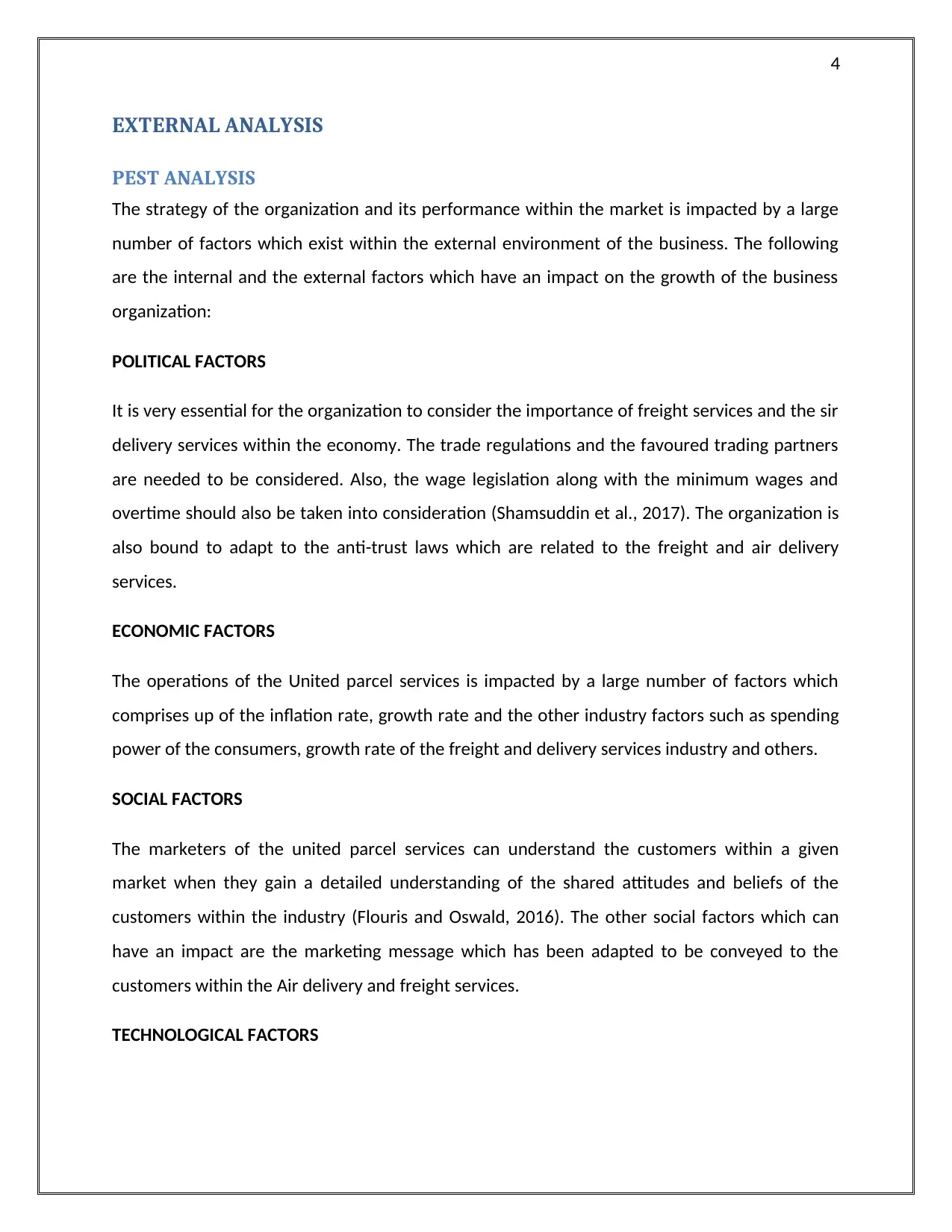
4
EXTERNAL ANALYSIS
PEST ANALYSIS
The strategy of the organization and its performance within the market is impacted by a large
number of factors which exist within the external environment of the business. The following
are the internal and the external factors which have an impact on the growth of the business
organization:
POLITICAL FACTORS
It is very essential for the organization to consider the importance of freight services and the sir
delivery services within the economy. The trade regulations and the favoured trading partners
are needed to be considered. Also, the wage legislation along with the minimum wages and
overtime should also be taken into consideration (Shamsuddin et al., 2017). The organization is
also bound to adapt to the anti-trust laws which are related to the freight and air delivery
services.
ECONOMIC FACTORS
The operations of the United parcel services is impacted by a large number of factors which
comprises up of the inflation rate, growth rate and the other industry factors such as spending
power of the consumers, growth rate of the freight and delivery services industry and others.
SOCIAL FACTORS
The marketers of the united parcel services can understand the customers within a given
market when they gain a detailed understanding of the shared attitudes and beliefs of the
customers within the industry (Flouris and Oswald, 2016). The other social factors which can
have an impact are the marketing message which has been adapted to be conveyed to the
customers within the Air delivery and freight services.
TECHNOLOGICAL FACTORS
EXTERNAL ANALYSIS
PEST ANALYSIS
The strategy of the organization and its performance within the market is impacted by a large
number of factors which exist within the external environment of the business. The following
are the internal and the external factors which have an impact on the growth of the business
organization:
POLITICAL FACTORS
It is very essential for the organization to consider the importance of freight services and the sir
delivery services within the economy. The trade regulations and the favoured trading partners
are needed to be considered. Also, the wage legislation along with the minimum wages and
overtime should also be taken into consideration (Shamsuddin et al., 2017). The organization is
also bound to adapt to the anti-trust laws which are related to the freight and air delivery
services.
ECONOMIC FACTORS
The operations of the United parcel services is impacted by a large number of factors which
comprises up of the inflation rate, growth rate and the other industry factors such as spending
power of the consumers, growth rate of the freight and delivery services industry and others.
SOCIAL FACTORS
The marketers of the united parcel services can understand the customers within a given
market when they gain a detailed understanding of the shared attitudes and beliefs of the
customers within the industry (Flouris and Oswald, 2016). The other social factors which can
have an impact are the marketing message which has been adapted to be conveyed to the
customers within the Air delivery and freight services.
TECHNOLOGICAL FACTORS
Paraphrase This Document
Need a fresh take? Get an instant paraphrase of this document with our AI Paraphraser
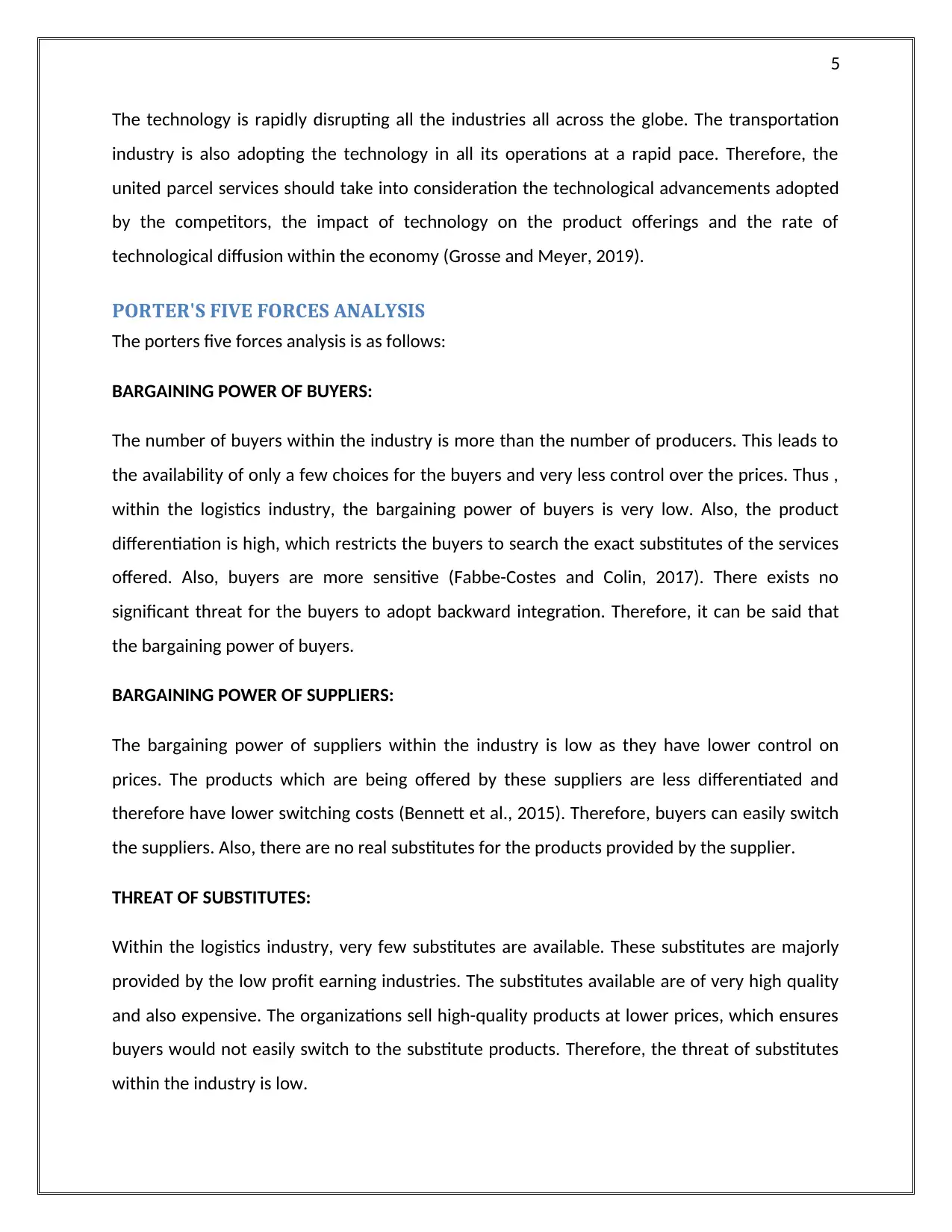
5
The technology is rapidly disrupting all the industries all across the globe. The transportation
industry is also adopting the technology in all its operations at a rapid pace. Therefore, the
united parcel services should take into consideration the technological advancements adopted
by the competitors, the impact of technology on the product offerings and the rate of
technological diffusion within the economy (Grosse and Meyer, 2019).
PORTER'S FIVE FORCES ANALYSIS
The porters five forces analysis is as follows:
BARGAINING POWER OF BUYERS:
The number of buyers within the industry is more than the number of producers. This leads to
the availability of only a few choices for the buyers and very less control over the prices. Thus ,
within the logistics industry, the bargaining power of buyers is very low. Also, the product
differentiation is high, which restricts the buyers to search the exact substitutes of the services
offered. Also, buyers are more sensitive (Fabbe-Costes and Colin, 2017). There exists no
significant threat for the buyers to adopt backward integration. Therefore, it can be said that
the bargaining power of buyers.
BARGAINING POWER OF SUPPLIERS:
The bargaining power of suppliers within the industry is low as they have lower control on
prices. The products which are being offered by these suppliers are less differentiated and
therefore have lower switching costs (Bennett et al., 2015). Therefore, buyers can easily switch
the suppliers. Also, there are no real substitutes for the products provided by the supplier.
THREAT OF SUBSTITUTES:
Within the logistics industry, very few substitutes are available. These substitutes are majorly
provided by the low profit earning industries. The substitutes available are of very high quality
and also expensive. The organizations sell high-quality products at lower prices, which ensures
buyers would not easily switch to the substitute products. Therefore, the threat of substitutes
within the industry is low.
The technology is rapidly disrupting all the industries all across the globe. The transportation
industry is also adopting the technology in all its operations at a rapid pace. Therefore, the
united parcel services should take into consideration the technological advancements adopted
by the competitors, the impact of technology on the product offerings and the rate of
technological diffusion within the economy (Grosse and Meyer, 2019).
PORTER'S FIVE FORCES ANALYSIS
The porters five forces analysis is as follows:
BARGAINING POWER OF BUYERS:
The number of buyers within the industry is more than the number of producers. This leads to
the availability of only a few choices for the buyers and very less control over the prices. Thus ,
within the logistics industry, the bargaining power of buyers is very low. Also, the product
differentiation is high, which restricts the buyers to search the exact substitutes of the services
offered. Also, buyers are more sensitive (Fabbe-Costes and Colin, 2017). There exists no
significant threat for the buyers to adopt backward integration. Therefore, it can be said that
the bargaining power of buyers.
BARGAINING POWER OF SUPPLIERS:
The bargaining power of suppliers within the industry is low as they have lower control on
prices. The products which are being offered by these suppliers are less differentiated and
therefore have lower switching costs (Bennett et al., 2015). Therefore, buyers can easily switch
the suppliers. Also, there are no real substitutes for the products provided by the supplier.
THREAT OF SUBSTITUTES:
Within the logistics industry, very few substitutes are available. These substitutes are majorly
provided by the low profit earning industries. The substitutes available are of very high quality
and also expensive. The organizations sell high-quality products at lower prices, which ensures
buyers would not easily switch to the substitute products. Therefore, the threat of substitutes
within the industry is low.
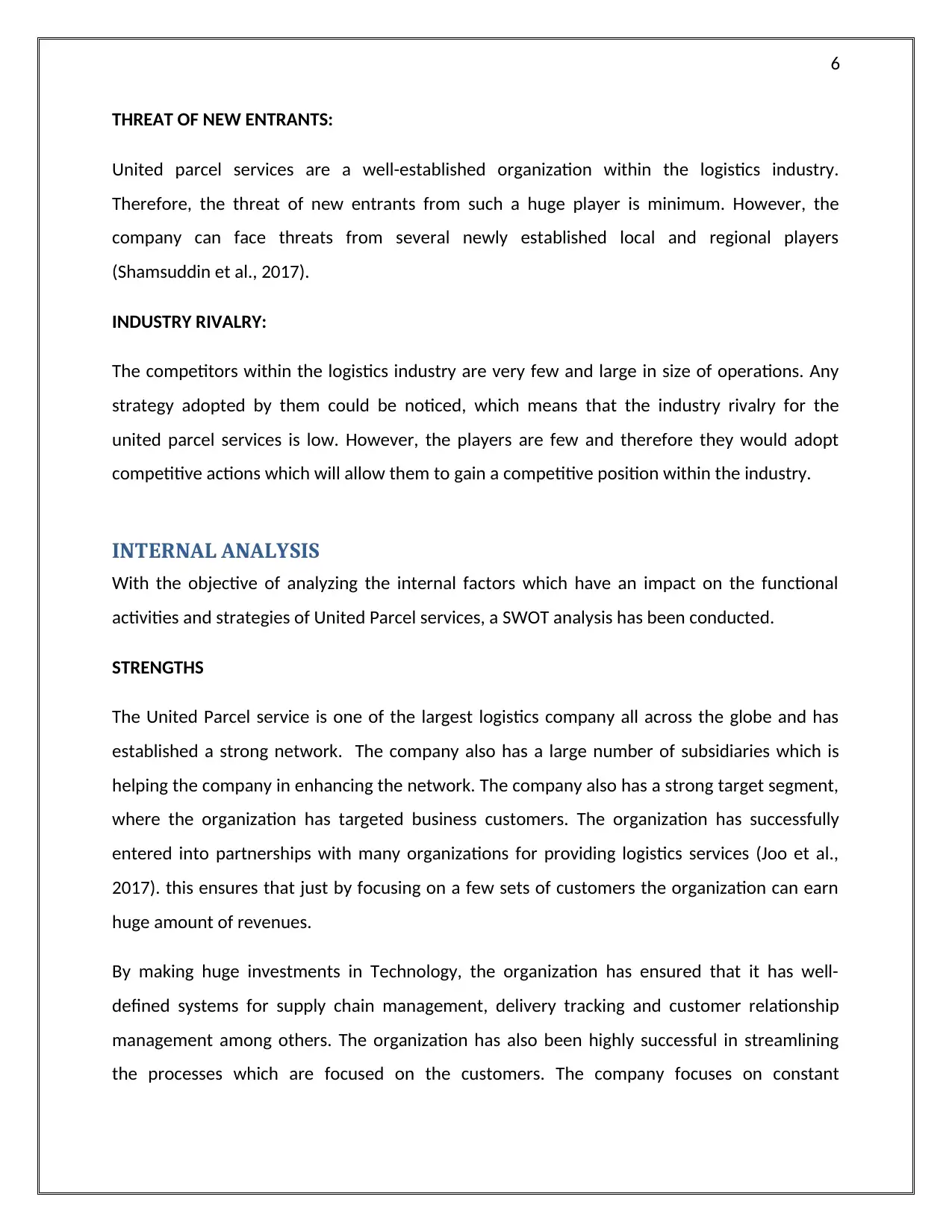
6
THREAT OF NEW ENTRANTS:
United parcel services are a well-established organization within the logistics industry.
Therefore, the threat of new entrants from such a huge player is minimum. However, the
company can face threats from several newly established local and regional players
(Shamsuddin et al., 2017).
INDUSTRY RIVALRY:
The competitors within the logistics industry are very few and large in size of operations. Any
strategy adopted by them could be noticed, which means that the industry rivalry for the
united parcel services is low. However, the players are few and therefore they would adopt
competitive actions which will allow them to gain a competitive position within the industry.
INTERNAL ANALYSIS
With the objective of analyzing the internal factors which have an impact on the functional
activities and strategies of United Parcel services, a SWOT analysis has been conducted.
STRENGTHS
The United Parcel service is one of the largest logistics company all across the globe and has
established a strong network. The company also has a large number of subsidiaries which is
helping the company in enhancing the network. The company also has a strong target segment,
where the organization has targeted business customers. The organization has successfully
entered into partnerships with many organizations for providing logistics services (Joo et al.,
2017). this ensures that just by focusing on a few sets of customers the organization can earn
huge amount of revenues.
By making huge investments in Technology, the organization has ensured that it has well-
defined systems for supply chain management, delivery tracking and customer relationship
management among others. The organization has also been highly successful in streamlining
the processes which are focused on the customers. The company focuses on constant
THREAT OF NEW ENTRANTS:
United parcel services are a well-established organization within the logistics industry.
Therefore, the threat of new entrants from such a huge player is minimum. However, the
company can face threats from several newly established local and regional players
(Shamsuddin et al., 2017).
INDUSTRY RIVALRY:
The competitors within the logistics industry are very few and large in size of operations. Any
strategy adopted by them could be noticed, which means that the industry rivalry for the
united parcel services is low. However, the players are few and therefore they would adopt
competitive actions which will allow them to gain a competitive position within the industry.
INTERNAL ANALYSIS
With the objective of analyzing the internal factors which have an impact on the functional
activities and strategies of United Parcel services, a SWOT analysis has been conducted.
STRENGTHS
The United Parcel service is one of the largest logistics company all across the globe and has
established a strong network. The company also has a large number of subsidiaries which is
helping the company in enhancing the network. The company also has a strong target segment,
where the organization has targeted business customers. The organization has successfully
entered into partnerships with many organizations for providing logistics services (Joo et al.,
2017). this ensures that just by focusing on a few sets of customers the organization can earn
huge amount of revenues.
By making huge investments in Technology, the organization has ensured that it has well-
defined systems for supply chain management, delivery tracking and customer relationship
management among others. The organization has also been highly successful in streamlining
the processes which are focused on the customers. The company focuses on constant
⊘ This is a preview!⊘
Do you want full access?
Subscribe today to unlock all pages.

Trusted by 1+ million students worldwide
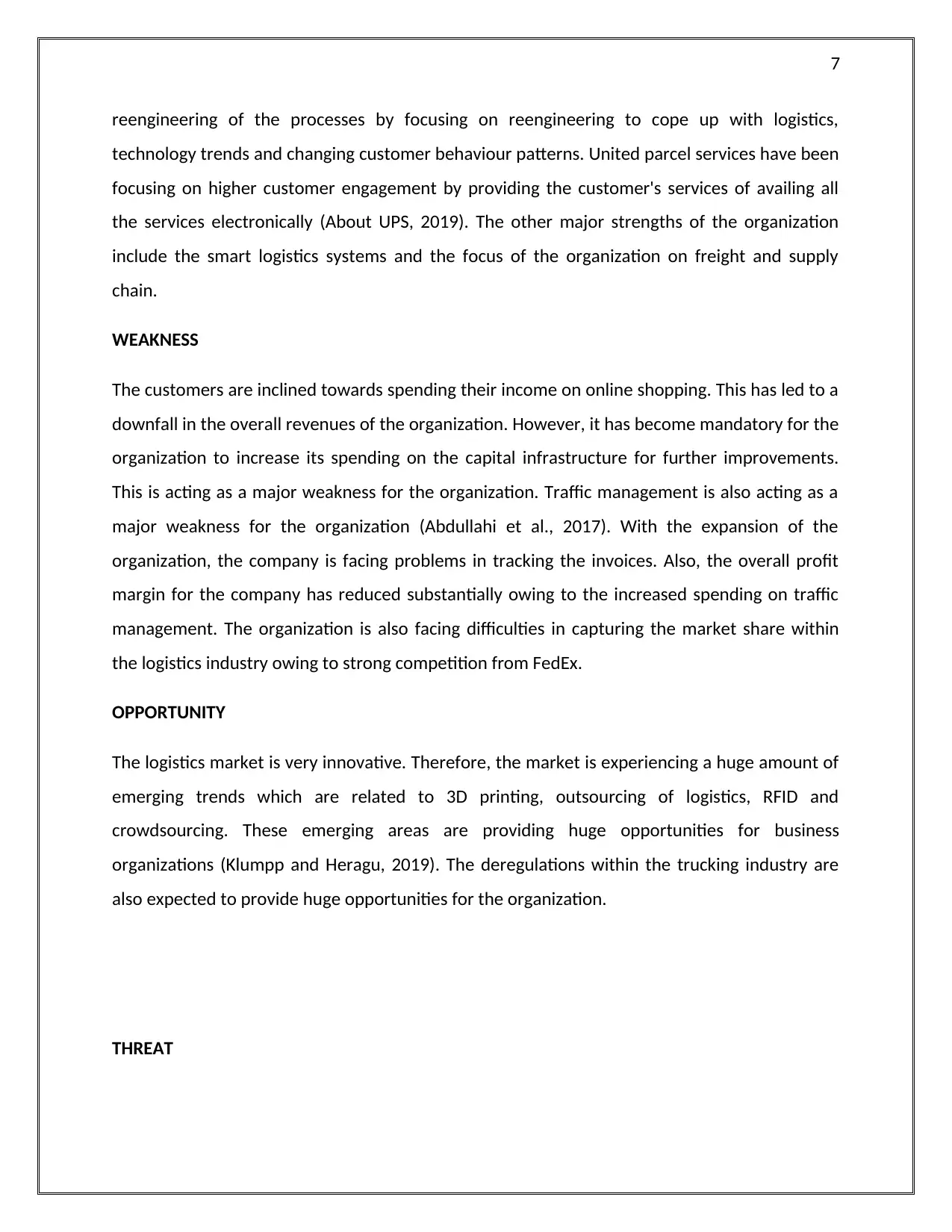
7
reengineering of the processes by focusing on reengineering to cope up with logistics,
technology trends and changing customer behaviour patterns. United parcel services have been
focusing on higher customer engagement by providing the customer's services of availing all
the services electronically (About UPS, 2019). The other major strengths of the organization
include the smart logistics systems and the focus of the organization on freight and supply
chain.
WEAKNESS
The customers are inclined towards spending their income on online shopping. This has led to a
downfall in the overall revenues of the organization. However, it has become mandatory for the
organization to increase its spending on the capital infrastructure for further improvements.
This is acting as a major weakness for the organization. Traffic management is also acting as a
major weakness for the organization (Abdullahi et al., 2017). With the expansion of the
organization, the company is facing problems in tracking the invoices. Also, the overall profit
margin for the company has reduced substantially owing to the increased spending on traffic
management. The organization is also facing difficulties in capturing the market share within
the logistics industry owing to strong competition from FedEx.
OPPORTUNITY
The logistics market is very innovative. Therefore, the market is experiencing a huge amount of
emerging trends which are related to 3D printing, outsourcing of logistics, RFID and
crowdsourcing. These emerging areas are providing huge opportunities for business
organizations (Klumpp and Heragu, 2019). The deregulations within the trucking industry are
also expected to provide huge opportunities for the organization.
THREAT
reengineering of the processes by focusing on reengineering to cope up with logistics,
technology trends and changing customer behaviour patterns. United parcel services have been
focusing on higher customer engagement by providing the customer's services of availing all
the services electronically (About UPS, 2019). The other major strengths of the organization
include the smart logistics systems and the focus of the organization on freight and supply
chain.
WEAKNESS
The customers are inclined towards spending their income on online shopping. This has led to a
downfall in the overall revenues of the organization. However, it has become mandatory for the
organization to increase its spending on the capital infrastructure for further improvements.
This is acting as a major weakness for the organization. Traffic management is also acting as a
major weakness for the organization (Abdullahi et al., 2017). With the expansion of the
organization, the company is facing problems in tracking the invoices. Also, the overall profit
margin for the company has reduced substantially owing to the increased spending on traffic
management. The organization is also facing difficulties in capturing the market share within
the logistics industry owing to strong competition from FedEx.
OPPORTUNITY
The logistics market is very innovative. Therefore, the market is experiencing a huge amount of
emerging trends which are related to 3D printing, outsourcing of logistics, RFID and
crowdsourcing. These emerging areas are providing huge opportunities for business
organizations (Klumpp and Heragu, 2019). The deregulations within the trucking industry are
also expected to provide huge opportunities for the organization.
THREAT
Paraphrase This Document
Need a fresh take? Get an instant paraphrase of this document with our AI Paraphraser
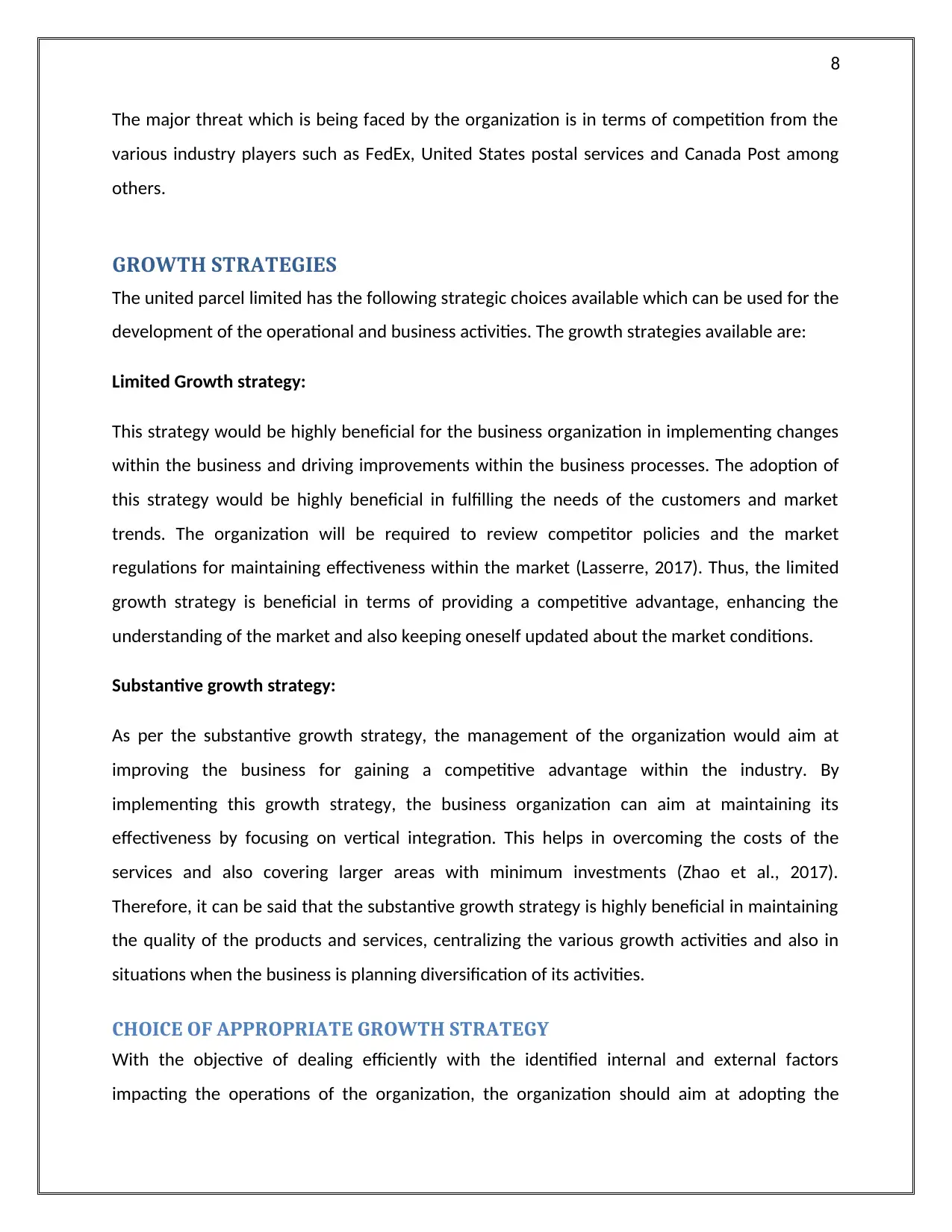
8
The major threat which is being faced by the organization is in terms of competition from the
various industry players such as FedEx, United States postal services and Canada Post among
others.
GROWTH STRATEGIES
The united parcel limited has the following strategic choices available which can be used for the
development of the operational and business activities. The growth strategies available are:
Limited Growth strategy:
This strategy would be highly beneficial for the business organization in implementing changes
within the business and driving improvements within the business processes. The adoption of
this strategy would be highly beneficial in fulfilling the needs of the customers and market
trends. The organization will be required to review competitor policies and the market
regulations for maintaining effectiveness within the market (Lasserre, 2017). Thus, the limited
growth strategy is beneficial in terms of providing a competitive advantage, enhancing the
understanding of the market and also keeping oneself updated about the market conditions.
Substantive growth strategy:
As per the substantive growth strategy, the management of the organization would aim at
improving the business for gaining a competitive advantage within the industry. By
implementing this growth strategy, the business organization can aim at maintaining its
effectiveness by focusing on vertical integration. This helps in overcoming the costs of the
services and also covering larger areas with minimum investments (Zhao et al., 2017).
Therefore, it can be said that the substantive growth strategy is highly beneficial in maintaining
the quality of the products and services, centralizing the various growth activities and also in
situations when the business is planning diversification of its activities.
CHOICE OF APPROPRIATE GROWTH STRATEGY
With the objective of dealing efficiently with the identified internal and external factors
impacting the operations of the organization, the organization should aim at adopting the
The major threat which is being faced by the organization is in terms of competition from the
various industry players such as FedEx, United States postal services and Canada Post among
others.
GROWTH STRATEGIES
The united parcel limited has the following strategic choices available which can be used for the
development of the operational and business activities. The growth strategies available are:
Limited Growth strategy:
This strategy would be highly beneficial for the business organization in implementing changes
within the business and driving improvements within the business processes. The adoption of
this strategy would be highly beneficial in fulfilling the needs of the customers and market
trends. The organization will be required to review competitor policies and the market
regulations for maintaining effectiveness within the market (Lasserre, 2017). Thus, the limited
growth strategy is beneficial in terms of providing a competitive advantage, enhancing the
understanding of the market and also keeping oneself updated about the market conditions.
Substantive growth strategy:
As per the substantive growth strategy, the management of the organization would aim at
improving the business for gaining a competitive advantage within the industry. By
implementing this growth strategy, the business organization can aim at maintaining its
effectiveness by focusing on vertical integration. This helps in overcoming the costs of the
services and also covering larger areas with minimum investments (Zhao et al., 2017).
Therefore, it can be said that the substantive growth strategy is highly beneficial in maintaining
the quality of the products and services, centralizing the various growth activities and also in
situations when the business is planning diversification of its activities.
CHOICE OF APPROPRIATE GROWTH STRATEGY
With the objective of dealing efficiently with the identified internal and external factors
impacting the operations of the organization, the organization should aim at adopting the
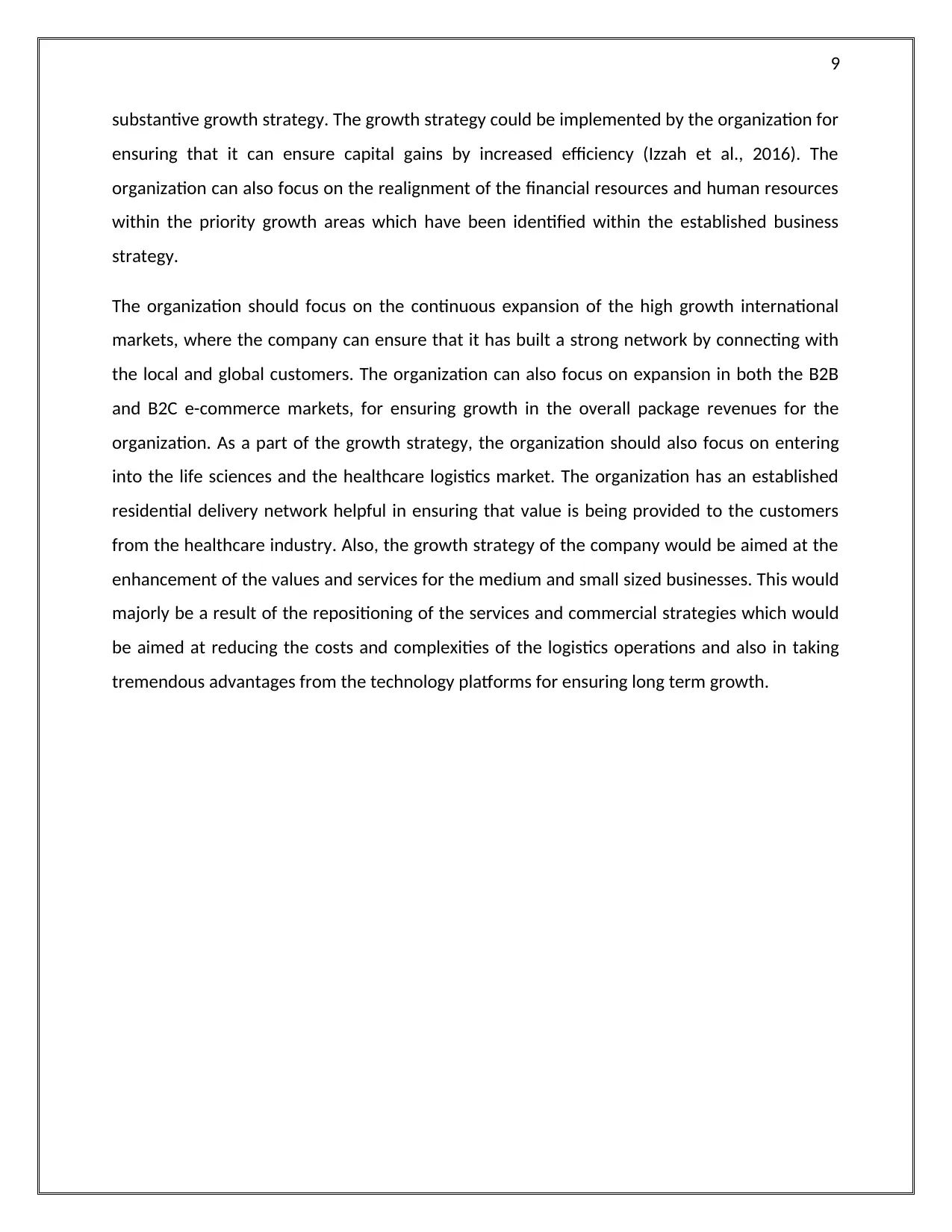
9
substantive growth strategy. The growth strategy could be implemented by the organization for
ensuring that it can ensure capital gains by increased efficiency (Izzah et al., 2016). The
organization can also focus on the realignment of the financial resources and human resources
within the priority growth areas which have been identified within the established business
strategy.
The organization should focus on the continuous expansion of the high growth international
markets, where the company can ensure that it has built a strong network by connecting with
the local and global customers. The organization can also focus on expansion in both the B2B
and B2C e-commerce markets, for ensuring growth in the overall package revenues for the
organization. As a part of the growth strategy, the organization should also focus on entering
into the life sciences and the healthcare logistics market. The organization has an established
residential delivery network helpful in ensuring that value is being provided to the customers
from the healthcare industry. Also, the growth strategy of the company would be aimed at the
enhancement of the values and services for the medium and small sized businesses. This would
majorly be a result of the repositioning of the services and commercial strategies which would
be aimed at reducing the costs and complexities of the logistics operations and also in taking
tremendous advantages from the technology platforms for ensuring long term growth.
substantive growth strategy. The growth strategy could be implemented by the organization for
ensuring that it can ensure capital gains by increased efficiency (Izzah et al., 2016). The
organization can also focus on the realignment of the financial resources and human resources
within the priority growth areas which have been identified within the established business
strategy.
The organization should focus on the continuous expansion of the high growth international
markets, where the company can ensure that it has built a strong network by connecting with
the local and global customers. The organization can also focus on expansion in both the B2B
and B2C e-commerce markets, for ensuring growth in the overall package revenues for the
organization. As a part of the growth strategy, the organization should also focus on entering
into the life sciences and the healthcare logistics market. The organization has an established
residential delivery network helpful in ensuring that value is being provided to the customers
from the healthcare industry. Also, the growth strategy of the company would be aimed at the
enhancement of the values and services for the medium and small sized businesses. This would
majorly be a result of the repositioning of the services and commercial strategies which would
be aimed at reducing the costs and complexities of the logistics operations and also in taking
tremendous advantages from the technology platforms for ensuring long term growth.
⊘ This is a preview!⊘
Do you want full access?
Subscribe today to unlock all pages.

Trusted by 1+ million students worldwide
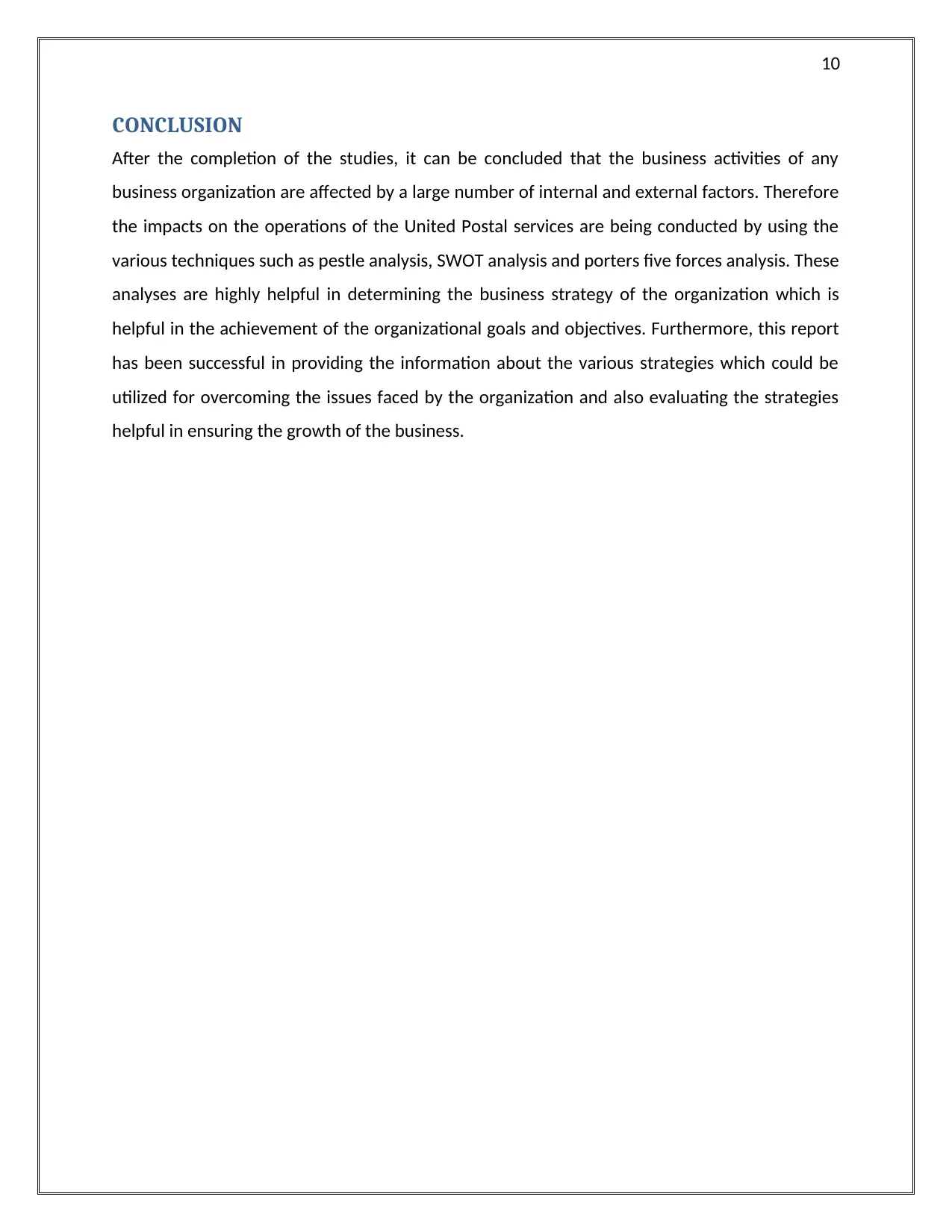
10
CONCLUSION
After the completion of the studies, it can be concluded that the business activities of any
business organization are affected by a large number of internal and external factors. Therefore
the impacts on the operations of the United Postal services are being conducted by using the
various techniques such as pestle analysis, SWOT analysis and porters five forces analysis. These
analyses are highly helpful in determining the business strategy of the organization which is
helpful in the achievement of the organizational goals and objectives. Furthermore, this report
has been successful in providing the information about the various strategies which could be
utilized for overcoming the issues faced by the organization and also evaluating the strategies
helpful in ensuring the growth of the business.
CONCLUSION
After the completion of the studies, it can be concluded that the business activities of any
business organization are affected by a large number of internal and external factors. Therefore
the impacts on the operations of the United Postal services are being conducted by using the
various techniques such as pestle analysis, SWOT analysis and porters five forces analysis. These
analyses are highly helpful in determining the business strategy of the organization which is
helpful in the achievement of the organizational goals and objectives. Furthermore, this report
has been successful in providing the information about the various strategies which could be
utilized for overcoming the issues faced by the organization and also evaluating the strategies
helpful in ensuring the growth of the business.
Paraphrase This Document
Need a fresh take? Get an instant paraphrase of this document with our AI Paraphraser
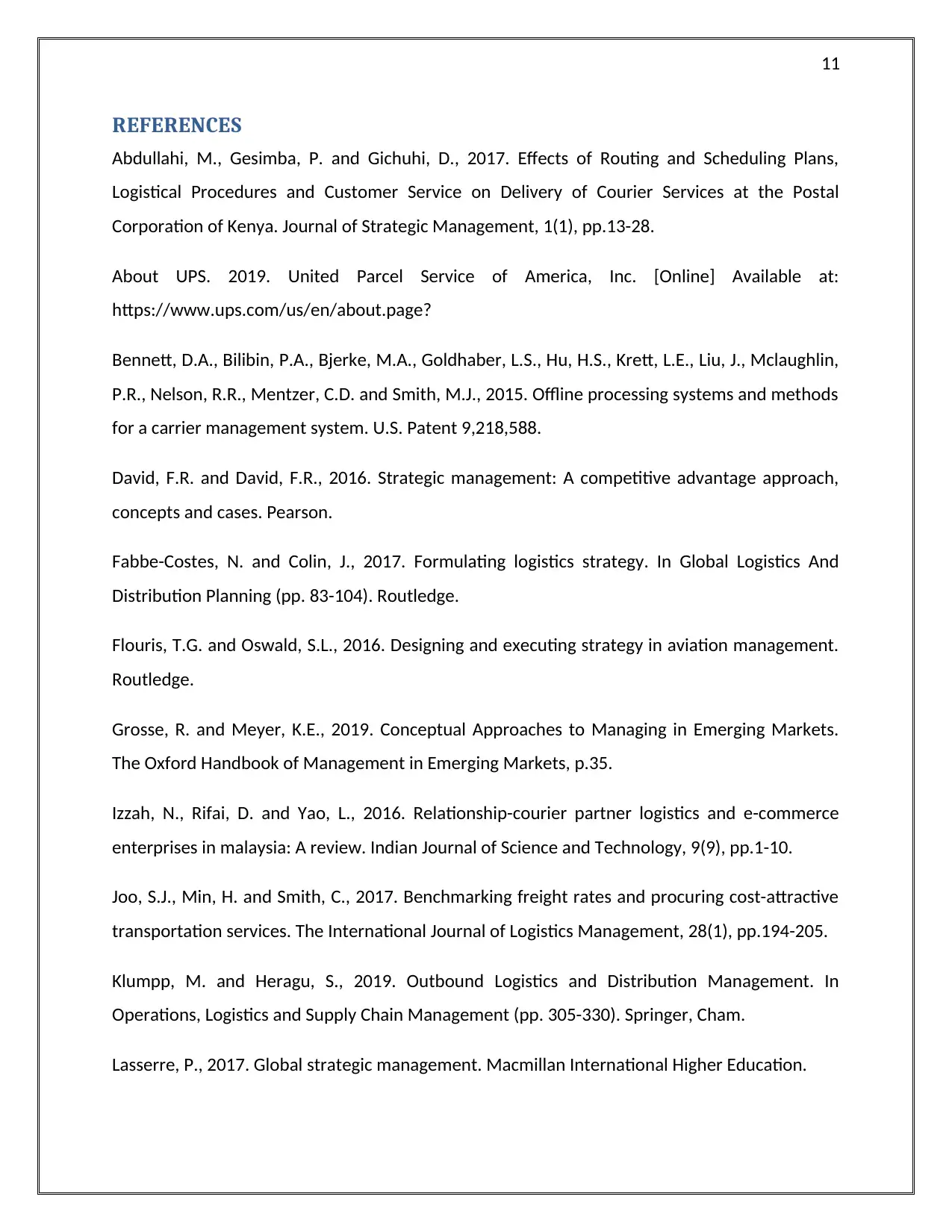
11
REFERENCES
Abdullahi, M., Gesimba, P. and Gichuhi, D., 2017. Effects of Routing and Scheduling Plans,
Logistical Procedures and Customer Service on Delivery of Courier Services at the Postal
Corporation of Kenya. Journal of Strategic Management, 1(1), pp.13-28.
About UPS. 2019. United Parcel Service of America, Inc. [Online] Available at:
https://www.ups.com/us/en/about.page?
Bennett, D.A., Bilibin, P.A., Bjerke, M.A., Goldhaber, L.S., Hu, H.S., Krett, L.E., Liu, J., Mclaughlin,
P.R., Nelson, R.R., Mentzer, C.D. and Smith, M.J., 2015. Offline processing systems and methods
for a carrier management system. U.S. Patent 9,218,588.
David, F.R. and David, F.R., 2016. Strategic management: A competitive advantage approach,
concepts and cases. Pearson.
Fabbe-Costes, N. and Colin, J., 2017. Formulating logistics strategy. In Global Logistics And
Distribution Planning (pp. 83-104). Routledge.
Flouris, T.G. and Oswald, S.L., 2016. Designing and executing strategy in aviation management.
Routledge.
Grosse, R. and Meyer, K.E., 2019. Conceptual Approaches to Managing in Emerging Markets.
The Oxford Handbook of Management in Emerging Markets, p.35.
Izzah, N., Rifai, D. and Yao, L., 2016. Relationship-courier partner logistics and e-commerce
enterprises in malaysia: A review. Indian Journal of Science and Technology, 9(9), pp.1-10.
Joo, S.J., Min, H. and Smith, C., 2017. Benchmarking freight rates and procuring cost-attractive
transportation services. The International Journal of Logistics Management, 28(1), pp.194-205.
Klumpp, M. and Heragu, S., 2019. Outbound Logistics and Distribution Management. In
Operations, Logistics and Supply Chain Management (pp. 305-330). Springer, Cham.
Lasserre, P., 2017. Global strategic management. Macmillan International Higher Education.
REFERENCES
Abdullahi, M., Gesimba, P. and Gichuhi, D., 2017. Effects of Routing and Scheduling Plans,
Logistical Procedures and Customer Service on Delivery of Courier Services at the Postal
Corporation of Kenya. Journal of Strategic Management, 1(1), pp.13-28.
About UPS. 2019. United Parcel Service of America, Inc. [Online] Available at:
https://www.ups.com/us/en/about.page?
Bennett, D.A., Bilibin, P.A., Bjerke, M.A., Goldhaber, L.S., Hu, H.S., Krett, L.E., Liu, J., Mclaughlin,
P.R., Nelson, R.R., Mentzer, C.D. and Smith, M.J., 2015. Offline processing systems and methods
for a carrier management system. U.S. Patent 9,218,588.
David, F.R. and David, F.R., 2016. Strategic management: A competitive advantage approach,
concepts and cases. Pearson.
Fabbe-Costes, N. and Colin, J., 2017. Formulating logistics strategy. In Global Logistics And
Distribution Planning (pp. 83-104). Routledge.
Flouris, T.G. and Oswald, S.L., 2016. Designing and executing strategy in aviation management.
Routledge.
Grosse, R. and Meyer, K.E., 2019. Conceptual Approaches to Managing in Emerging Markets.
The Oxford Handbook of Management in Emerging Markets, p.35.
Izzah, N., Rifai, D. and Yao, L., 2016. Relationship-courier partner logistics and e-commerce
enterprises in malaysia: A review. Indian Journal of Science and Technology, 9(9), pp.1-10.
Joo, S.J., Min, H. and Smith, C., 2017. Benchmarking freight rates and procuring cost-attractive
transportation services. The International Journal of Logistics Management, 28(1), pp.194-205.
Klumpp, M. and Heragu, S., 2019. Outbound Logistics and Distribution Management. In
Operations, Logistics and Supply Chain Management (pp. 305-330). Springer, Cham.
Lasserre, P., 2017. Global strategic management. Macmillan International Higher Education.
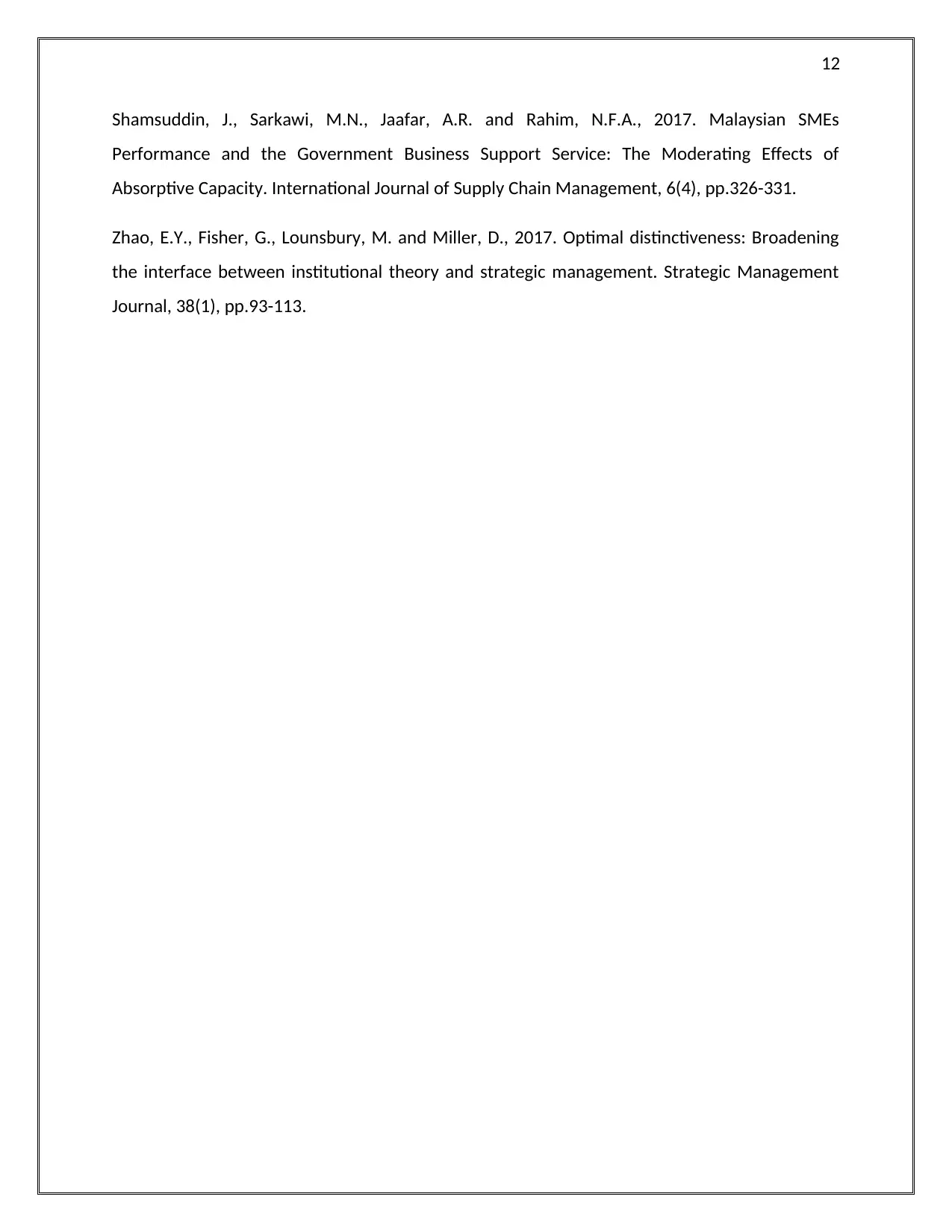
12
Shamsuddin, J., Sarkawi, M.N., Jaafar, A.R. and Rahim, N.F.A., 2017. Malaysian SMEs
Performance and the Government Business Support Service: The Moderating Effects of
Absorptive Capacity. International Journal of Supply Chain Management, 6(4), pp.326-331.
Zhao, E.Y., Fisher, G., Lounsbury, M. and Miller, D., 2017. Optimal distinctiveness: Broadening
the interface between institutional theory and strategic management. Strategic Management
Journal, 38(1), pp.93-113.
Shamsuddin, J., Sarkawi, M.N., Jaafar, A.R. and Rahim, N.F.A., 2017. Malaysian SMEs
Performance and the Government Business Support Service: The Moderating Effects of
Absorptive Capacity. International Journal of Supply Chain Management, 6(4), pp.326-331.
Zhao, E.Y., Fisher, G., Lounsbury, M. and Miller, D., 2017. Optimal distinctiveness: Broadening
the interface between institutional theory and strategic management. Strategic Management
Journal, 38(1), pp.93-113.
⊘ This is a preview!⊘
Do you want full access?
Subscribe today to unlock all pages.

Trusted by 1+ million students worldwide
1 out of 12
Related Documents
Your All-in-One AI-Powered Toolkit for Academic Success.
+13062052269
info@desklib.com
Available 24*7 on WhatsApp / Email
![[object Object]](/_next/static/media/star-bottom.7253800d.svg)
Unlock your academic potential
Copyright © 2020–2025 A2Z Services. All Rights Reserved. Developed and managed by ZUCOL.




